Introduction:
Dental crowns and bridges are essential components of restorative dentistry, helping individuals regain the functionality and aesthetics of their smiles. This comprehensive guide aims to provide a thorough understanding of dental crowns and bridges, from their purpose and types to the procedure involved and aftercare tips.
Purpose of Dental Crowns and Bridges:
Dental crowns and bridges serve crucial functions in restoring damaged or missing teeth. Crowns are used to cover and protect weakened or decayed teeth, restoring their strength and appearance. Bridges, on the other hand, are used to replace one or more missing teeth by anchoring artificial teeth to adjacent natural teeth or dental implants.
Types of Dental Crowns:
1. Ceramic Crowns: Known for their natural appearance, ceramic crowns blend seamlessly with surrounding teeth, making them ideal for front teeth restoration.
2. Porcelain-Fused-to-Metal (PFM) Crowns: These crowns combine the strength of metal with the aesthetics of porcelain, offering durability and a natural look.
3. Metal Crowns: Made from materials like gold or stainless steel, metal crowns are exceptionally strong and resistant to wear, making them suitable for molars.
4. Zirconia Crowns: Zirconia crowns are highly durable and aesthetically pleasing, making them a popular choice for both front and back teeth restoration.
Types of Dental Bridges:
1. Traditional Bridges: Traditional bridges consist of one or more pontic teeth (artificial teeth) held in place by dental crowns placed on adjacent natural teeth.
2. Cantilever Bridges: Cantilever bridges are used when there is only one adjacent tooth available for support. They are not as common as traditional bridges due to their limited application.
3. Maryland Bridges: Also known as resin-bonded bridges, Maryland bridges use metal or porcelain frameworks bonded to the back of adjacent teeth with resin cement.
4. Implant-Supported Bridges: These bridges are anchored to dental implants surgically placed in the jawbone, providing a stable and long-lasting solution for replacing missing teeth.
Procedure:
1. Examination and Preparation: During the initial consultation, the dentist examines the affected teeth and discusses treatment options with the patient. If crowns or bridges are deemed suitable, the dentist prepares the teeth by removing a small portion of enamel to accommodate the restoration.
2. Impression: An impression of the prepared teeth is taken to create custom-made crowns or bridges that fit seamlessly.
3. Temporary Restoration (if necessary): While the permanent restoration is being fabricated in a dental laboratory, temporary crowns or bridges may be placed to protect the teeth.
4. Placement: Once the permanent restoration is ready, it is carefully fitted and cemented into place by the dentist.
5. Final Adjustments: The dentist makes any necessary adjustments to ensure proper fit and bite alignment.
Aftercare Tips:
1. Maintain Good Oral Hygiene: Brush twice a day, floss regularly, and rinse with an antibacterial mouthwash to keep your crowns and bridges clean and free from plaque buildup.
2. Avoid Hard Foods: Minimize consumption of hard or sticky foods that may damage or dislodge the restorations.
3. Attend Regular Dental Check-ups: Visit your dentist for routine check-ups and professional cleanings to ensure the longevity of your crowns and bridges.
4. Wear a Night Guard (if recommended): If you tend to clench or grind your teeth at night, wearing a night guard can help protect your restorations from damage.
Conclusion:
Dental crowns & bridge play a vital role in restoring both the function and aesthetics of your smile. By understanding their purpose, types, procedure, and aftercare tips, you can make informed decisions about your dental health and work towards achieving a confident and healthy smile for years to come.





Comments